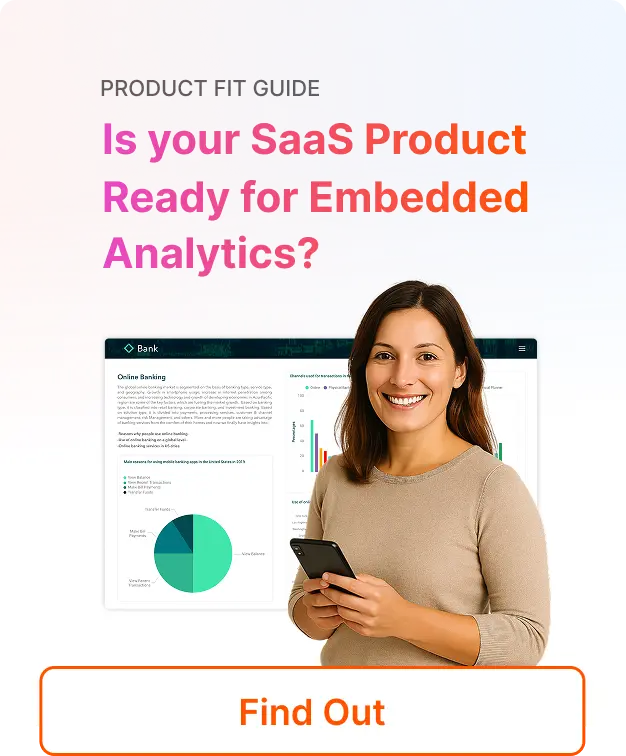As a data analytics professional, I believe data-driven decision-making is crucial in today’s competitive business world.
Organizations that effectively leverage their data to uncover insights and make informed choices gain an undeniable competitive edge. However, the exponential growth of data volume and complexity has made traditional manual analytics processes increasingly inadequate, time-consuming, and prone to errors.
What is Automated Analytics?
This is where automated analytics comes into play. At Qrvey, we see automated analytics as using advanced technologies to extract useful insights from data. All without needing human involvement.
It’s a comprehensive approach. It combines data ingestion, machine learning, predictive modeling, automated reporting, and continuous monitoring to streamline and optimize the entire analytics lifecycle.
Our core belief is that automating analytics empowers organizations to derive timely, accurate, and actionable insights.
It needs to originate from their data.
More importantly, it must scale efficiently. Your goal is to foster data-driven decision-making, improve operational efficiency, and drive business growth.
The Need for Automated Analytics
Traditional analytics processes face several critical challenges that automated analytics aims to address:
Data volume and velocity
Too much data coming in quickly can be too much for manual processes. This often results in missing chances and slow decision-making.
Manual effort and time-consuming processes
Extracting insights from data manually is difficult. Mistakes can occur during the process. The information may also become out-of-date by the time of analysis.
Consistency and accuracy issues
Human analysts may introduce biases or inconsistencies in their analyses, leading to unreliable or conflicting insights. Human error is always something you need to plan for.
Benefits of Automated Analytics
At Qrvey, we’ve witnessed firsthand the transformative power of automated analytics in enabling:
Data-driven decision-making
By providing real-time, actionable insights, automated analytics empowers organizations to make data-driven decisions quickly and confidently.
Speed to decision
Automated processes significantly reduce the time required to extract insights from data, allowing organizations to respond rapidly to market changes and customer needs.
Connecting systems for automating actions
Automated data analysis can seamlessly integrate with other systems and processes, enabling automated actions based on the derived insights, and further enhancing operational efficiency.
Key Components of Automated Analytics
Effectively automating analytics relies on several key components working in harmony:
Data ingestion and preparation
Automated processes for collecting, cleaning, and transforming data from various sources, ensuring data quality and readiness for analyzing.
Machine learning and predictive modeling
Leveraging advanced algorithms and techniques to identify patterns, make predictions, and uncover valuable insights within the data.
Automated reporting
Generating real-time reports, and dashboards that present insights in a clear and actionable way.
Continuous monitoring and alerting
Continuously monitor key performance indicators (KPIs). You will want real0time alerts when outliers exist to enable proactive decision-making.
Automated Analytics in Examples
At Qrvey, we’ve had the privilege of working with organizations across various industries. We’ve seen the tremendous impact of automated analytics in action:
Predictive maintenance in manufacturing:
By analyzing sensor data and machine logs, our automated analytics solutions can predict equipment failures. Integrating automation can then schedule maintenance proactively, minimizing downtime and reduce errors.
Fraud detection in finance:
Machine learning models automatically analyze big data and identify patterns indicative of fraudulent activities. This real-time process enables you to minimize financial losses in financial analytics.
Patient satisfaction for healthcare operations:
Automated analysis of patient feedback, electronic health records, and business data can identify areas for improvement. This might be to optimize processes to enhance patient satisfaction and overall care quality in healthcare analytics.
Types of Data Analytics Automation
There are several types of data analytics automation, each serving different purposes and leveraging various techniques. Some common types include:
- Automated Data Integration and Preparation: This involves automating data processing and ETL. It likely comes from multiple sources so data has to go through transformation to be ready for analysis. Automated data integration tools can streamline this process, reducing manual effort and saving time.
- Automated Exploratory Data Analysis (EDA): EDA is a crucial step in understanding the characteristics of data, identifying patterns, and generating insights. Automated EDA tools can perform statistical analysis, data visualization, and feature engineering, accelerating the exploration and comprehension of data.
- AutoML automates machine learning tasks like data preprocessing, model selection, tuning hyperparameters, and deploying models. It streamlines the workflow for efficiency. This empowers businesses to leverage advanced machine learning models without extensive data science expertise.
- Automated Reporting and Dashboarding tools create reports, visuals, and dashboards without manual work. They follow set rules or schedules to provide stakeholders with current and important information easily.
- Automated Monitoring and Alerting means that systems are constantly watching data for any unusual patterns. These systems send alerts or take action if something is not right or if there is room for improvement.
- Automated Decision Making. Some systems can automatically suggest or make the best decisions in certain areas. They use methods such as reinforcement learning, simulation, and optimization algorithms. They serve to reduce repetitive tasks.
When to Use Automated Data Analytics in Your Business
Here are a few examples of when to use automated analytics in a SaaS. The best embedded analytics tools will help enable many of these use cases in multi-tenant platforms:
- Automating analytics can help identify potential leads from sources like website interactions, marketing campaigns, and social media. This makes it easier to prioritize leads for sales follow-up.
- Machine learning models can score leads based on their likelihood to convert, enabling more effective allocation of sales resources.
- Automating lead nurturing triggers using lead scores and behavior patterns to improve conversion rates.
- Customer Retention and Churn Prediction: By monitoring customer usage patterns, support interactions, and feedback, automated analytics can identify customers at risk of churning.
- Predictive models can forecast customer churn probabilities, allowing proactive interventions and targeted retention campaigns.
- Analyzing customer data automatically can help businesses understand why customers are leaving. This understanding allows businesses to make improvements to their products and services.
- Product Usage and Feature Adoption: Automated analytics tools can track how customers interact with the SaaS product. Usage analytics helps to find features customer love, underutilized capabilities, and potential bottlenecks.
- Pricing and Revenue Optimization: Customer data, market trends, and pricing experiments are great sources of business intelligence data. It can reveal optimal pricing strategies for different customer segments or product tiers.
- Machine learning models can recommend dynamic pricing adjustments based on demand, competition, and willingness-to-pay signals.
- Automated optimization of pricing plans, discounts, and bundling strategies can maximize revenue and profitability.
- Sales and Marketing Automation: Automating analytics can segment customers based on their characteristics, behaviors, and needs, enabling more targeted and personalized marketing campaigns.
- Machine learning models can predict the best marketing channels, messages, and timing for different groups. This improves campaign results and return on investment.
- Process automation powers lead scoring, nurturing, and handoff to sales can streamline the sales process and improve conversion rates.
Implementing Automated Analytics
Successful implementation of automated analytics requires careful consideration of both technological requirements and organizational readiness:
Data infrastructure:
At Qrvey, we recognize the importance of robust data infrastructure. That’s why we’ve purposely built a multi-tenant data lake optimized for automated analytics. We go beyond simple reporting to include an automation workflow builder. This powerful combination allows our clients to create customized automated analytics solutions tailored to their unique needs.
Integration with existing systems:
We understand the importance of seamless integration. Our platform supports webhooks, data write-back, and custom API calls. This powers automation to connect to third-party systems, maximizing the speed of automated responses.
Data governance and data quality:
Ensuring data accuracy, consistency, and adherence to privacy and security regulations is essential for reliable automated analytics. We work closely with our clients to implement best practices in this area.
Upskilling and training:
At Qrvey, we believe in empowering our clients’ workforce with the necessary skills to leverage automated analytics effectively. We offer comprehensive training and development programs to facilitate this transformation.
Cultural shift towards data-driven decision-making:
Creating a culture that values using data for decision-making and supports using automated analytics is important for success. We partner with our clients to navigate this cultural shift, providing guidance and support every step of the way.
Best Practices and Considerations
While implementing automated analytics, we emphasize the importance of following best practices and addressing key considerations:
Data privacy and security
Robust measures must be in place to protect sensitive data and ensure compliance with relevant regulations. At Qrvey, we prioritize data privacy and security, working closely with our clients to implement industry-leading security protocols.
Interpretability and transparency
We believe that automated analytics models should be transparent. This allows stakeholders to understand the reasoning behind the insights and decisions.
Continuous model monitoring and maintenance
As data patterns evolve, it is essential to monitor and retrain models to maintain their accuracy and relevance. We provide ongoing monitoring and model maintenance services to ensure our clients’ solutions remain up-to-date and effective.
Balancing automation with human oversight
While automation can significantly enhance efficiency, we believe in the importance of human oversight and domain expertise.
The Future of Automated Analytics
The field of automated analytics is rapidly evolving. At Qrvey, we’re at the forefront of embracing emerging trends and technologies:
Automated machine learning (AutoML):
We are developing ways to automate the machine learning process. This will make it simpler for our clients to utilize automated analytics.
Explainable AI (XAI):
We are investing in explainable AI technologies to make our automated analytics models more transparent and understandable. This will help increase trust and confidence in the insights they provide.
Edge analytics and IoT:
With the increasing use of IoT devices, we are developing solutions for automated analysis to be conducted at the source. This enables faster decision-making and reduces the need for excessive bandwidth. This helps make decisions quickly and saves on bandwidth.
We see new chances in these improvements, but we know there are challenges like protecting data, managing models, and ethics. We are ready to help our clients deal with these challenges.
How Qrvey Helps
At Qrvey, we take great pride in being the only purpose-built embedded analytics platform specifically for SaaS companies. Our platform has a strong automation tool for SaaS platforms. It helps clients create their own automated analytics and workflows that fit their specific needs.
Our mission is to enable SaaS companies to leverage the full potential of automated analytics. We provide our customers with real-time, actionable tools.
All with the goal to drive data-driven decision-making. It can fuel business growth within your industry with a strong multi-tenant analytics feature.
Join us on this journey towards automated analytics excellence.

David is the Chief Technology Officer at Qrvey, the leading provider of embedded analytics software for B2B SaaS companies. With extensive experience in software development and a passion for innovation, David plays a pivotal role in helping companies successfully transition from traditional reporting features to highly customizable analytics experiences that delight SaaS end-users.
Drawing from his deep technical expertise and industry insights, David leads Qrvey’s engineering team in developing cutting-edge analytics solutions that empower product teams to seamlessly integrate robust data visualizations and interactive dashboards into their applications. His commitment to staying ahead of the curve ensures that Qrvey’s platform continuously evolves to meet the ever-changing needs of the SaaS industry.
David shares his wealth of knowledge and best practices on topics related to embedded analytics, data visualization, and the technical considerations involved in building data-driven SaaS products.
Popular Posts
Why is Multi-Tenant Analytics So Hard?
BLOG
Creating performant, secure, and scalable multi-tenant analytics requires overcoming steep engineering challenges that stretch the limits of...
How We Define Embedded Analytics
BLOG
Embedded analytics comes in many forms, but at Qrvey we focus exclusively on embedded analytics for SaaS applications. Discover the differences here...
White Labeling Your Analytics for Success
BLOG
When using third party analytics software you want it to blend in seamlessly to your application. Learn more on how and why this is important for user experience.









